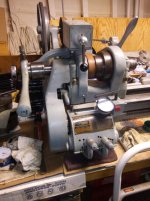Today I was using a 1/2" end mill to mill a 1/2" plate to a smaller size, and it started out ok, but after a while the end mill would slide into the collet and pull away from the work.
I tightened the collet up until I feel a "stop" at the end of the threaded area, and the end mill seems to be held pretty tight.
Is this a normal problem or is there some adjustment that I am not making? Is it possible that trying to cut 0.025" on a single pass at 633 rpms and 0.019" per revolution feed rate is too much?
Could the cutting oil be working up into the collet along the end mill shank and allowing it to slip?
Seems like this should be a simple set up,but not so far.
I tightened the collet up until I feel a "stop" at the end of the threaded area, and the end mill seems to be held pretty tight.
Is this a normal problem or is there some adjustment that I am not making? Is it possible that trying to cut 0.025" on a single pass at 633 rpms and 0.019" per revolution feed rate is too much?
Could the cutting oil be working up into the collet along the end mill shank and allowing it to slip?
Seems like this should be a simple set up,but not so far.



